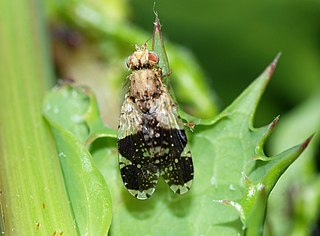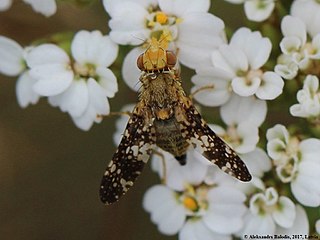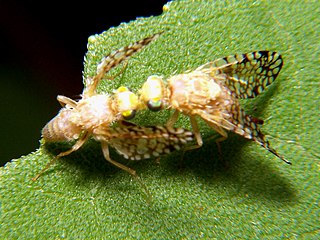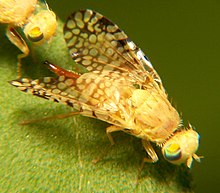
The Tephritidae are one of two fly families referred to as fruit flies, the other family being the Drosophilidae. The family Tephritidae does not include the biological model organisms of the genus Drosophila, which is often called the "common fruit fly". Nearly 5,000 described species of tephritid fruit fly are categorized in almost 500 genera of the Tephritidae. Description, recategorization, and genetic analyses are constantly changing the taxonomy of this family. To distinguish them from the Drosophilidae, the Tephritidae are sometimes called peacock flies, in reference to their elaborate and colorful markings. The name comes from the Greek τεφρος, tephros, meaning "ash grey". They are found in all the biogeographic realms.

The Pyrgotidae are an unusual family of flies (Diptera), one of only two families of Cyclorrhapha that lack ocelli. Most species are "picture-winged", as is typical among the Tephritoidea, but unlike other tephritoids, they are endoparasitoids; the females pursue scarab beetles in flight, laying an egg on the beetle's back under the elytra where the beetle cannot reach it. The egg hatches and the fly larva enters the body cavity of the beetle, feeding and eventually killing the host before pupating. In the United States, some species of Pyrgota and Sphecomyiella can be quite common in areas where their host beetles are abundant. Like their host beetles, these flies are primarily nocturnal, and are often attracted to artificial lights.

Acanthiophilus is a genus of tephritid or fruit flies in the family Tephritidae.

Neotephritis is a genus of tephritid or fruit flies in the family Tephritidae.

Tephritis is a genus of flies. It contains around 170 described species, making it the sixth largest genus in the family Tephritidae. Many more undescribed species are known from specimen collections. Tephritis occur throughout much of the world, but most are Palearctic. They can be found in a wide range of climate types, from hot semidesert to tundra. Most species inhabit the inflorescences of plants from several tribes in the family Asteraceae, and a few species cause galls to form.

Oxyna is a genus of fruit flies in the family Tephritidae. There are at least 20 described species in Oxyna.

Euaresta aequalis is a species of fruit fly in the genus Euaresta of the family Tephritidae.
Euaresta bella is a species of tephritid or fruit flies in the genus Euaresta of the family Tephritidae.
Euaresta bellula is a species of tephritid or fruit flies in the genus Euaresta of the family Tephritidae.
Euaresta bullans is a species of fruit fly in the genus Euaresta of the family Tephritidae.
Euaresta philodema is a species of fruit fly in the genus Euaresta of the family Tephritidae.
Euaresta stelligera is a species of fruit fly in the genus Euaresta of the family Tephritidae.
Euaresta stigmatica is a species of fruit fly in the genus Euaresta of the family Tephritidae.
Euaresta tapetis is a species of fruit fly in the genus Euaresta of the family Tephritidae.
Euaresta versicolor is a species of fruit fly in the genus Euaresta of the family Tephritidae.
Euaresta reticulata is a species of fruit fly in the genus Euaresta of the family Tephritidae.

Dioxyna is a genus of fruit flies in the family Tephritidae. There are about 10 described species in Dioxyna.

Tephritini is a tribe of fruit flies in the family Tephritidae. There are about 12 genera and at least 40 described species in Tephritini.

Neotephritis finalis, the sunflower seed maggot, is a species of fruit fly in the family Tephritidae.
Campiglossa murina is a species of fruit fly in the family Tephritidae.








